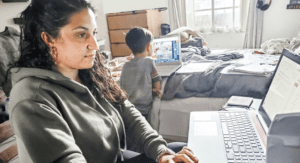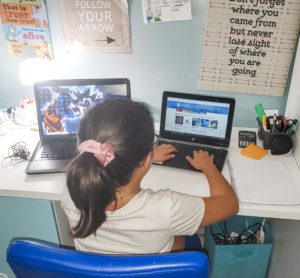Being a parent to a special needs child is especially trying at this season of our lives. But there is good and bad to this situation with COVID-19, quarantine, and distance learning. One thing is for sure: we are all going through this together.
I personally know what a handful it is to have your special needs children home all the time. So I took a step back to realize that maybe it is best to look at this as an opportunity instead of something bad happening. Either way, I needed to make lemonade out of the lemons I was dealt, at the moment. I decided my first step was to do lots of research and take notes to see what could help me make the most out of all of this.

These are the tips that have worked the best for my children. You can also check out the Miami Moms Blog Guide to Coronavirus & Social Distancing Resources.
1. Remember how unique your special needs child is and that they probably have changed during this time.
If you are anything like me, you have had this conversation with your child’s teacher about their weaknesses. Now is your chance to try and fix the situations to the best of your abilities at home. Also, keep in mind that their strengths and weaknesses at school will probably vary from those they have at home.
Remember so much has changed for them during this time. They are most likely nervous about the pandemic. Not to mention the fact that with distance learning they are now in a smaller class environment. Also, in some cases–mine, for example–your child does not see or speak to their teachers or other students at all. From my understanding, no teacher at my kids’ school is doing any type of Zoom class. My daughter’s teacher does YouTube videos explaining the lessons to them, so she at least gets to see her. But in my son’s case, he has had no contact with his teachers or friends since they have been out of school.
2. Review your child’s IEP and take a look at the recommended accommodations.
If your child is in the public school system, they most likely either have an IEP or a 504 plan. Now that your child is at home and doing distance learning they probably aren’t getting the same services they were receiving at school. What you can do is review their current IEP or 504 plan and look especially at the section about accommodations. In this section, it states the things the teachers agreed to do to help your child succeed.

Always keep in mind that each child is different and has individual needs, even if they have the same diagnosis.
Not all of these are possible to do at home or by you alone but the point is to do our best. For example, both my kid’s IEP and 504 plans include movement breaks. The point of movement breaks is so they can expend some of their pent up energy. Due to my son’s Asperger’s and ADHD he has a few more accommodations than my daughter who only has ADD.
3. Create a special place for them to use to do their daily work.
Even if it is just temporary the best way to help your special needs child is to give them their own special space with everything they need for their distance learning. My daughter has her own desk in her room. But my son, on the other hand, shares a room with his little 1 ½-year-old sister. What we did for him is set him up in his own area in his older sister’s room. He is near enough to his sister to ask her a question if he needs to, but far enough to where they do not distract each other. This way they also can close the door when the baby wakes up or she will go in there and “help them with their homework.”

4. Get the weekly curriculum from your child’s teacher and speak to them.
The schedule the teachers come up with doesn’t work for all students. You know your child better than anyone. Sometimes you need to tailor the curriculum to best suit your child while still accomplishing what they need for grades. Depending on your child, you might also want to add some extra activities or electives now that they are home and you have the opportunity to do so. You can customize your child’s curriculum and add topics that peak your child’s interests.

5. Make a daily routine for your special needs child but be flexible.
All children could use routines but special needs children thrive on them. This means that it is extremely important for your child to have a daily routine. They need to know what to expect for the day. Depending on their age you can either make a visual schedule or just an outline of the week. This also helps my son keep track of everything. Before the pandemic, I had a morning routine, after school routine, and a bedtime routine for my kids. What I’ve done for now is adjust it to fit our new needs.
One example that some parents might not agree with is the fact that I do not force my children to be up at 7 am right now. They get up around 9 am or 10 am and make sure they finish their distance learning assignments in a timely fashion.

My children’s schedules do not have times on them. They are more so they have an idea of what things they need to get done and for the most part in what order. My son is a stickler for following the order of his routines, my daughter not so much.
Understood.org has some examples of picture routines and learning contracts to use for your child.
One important thing I make sure to explain to my kids is that things come up and you need to be flexible. There are days when you will not be able to do everything on your routine or in the order you wanted to and that is ok. I explain to my son that we can just catch up another day and that everything is going to be ok even though it wasn’t planned that way.

















Great tips, Minnie! Thank you for sharing!
Comments are closed.